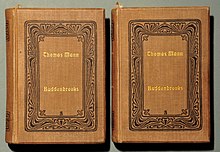
Back بودنبروك. قصة انهيار عائلة Arabic Buddenbroklar AZ بودنبروکلار AZB Buddenbrooks BAR Будэнброкі BE-X-OLD Буденброкови Bulgarian Buddenbrookovi Czech Huset Buddenbrook Danish Buddenbrooks German Buddenbrooks EO
This article needs additional citations for verification. (December 2012) |
 First edition (two volumes) covers | |
| Author | Thomas Mann |
|---|---|
| Original title | Buddenbrooks: Verfall einer Familie |
| Language | German |
| Genre | Family saga |
| Publisher | S. Fischer Verlag, Berlin |
Publication date | 1901 |
| Publication place | Germany |
| OCLC | 16705387 |
| 833.9/12 | |
Original text | Buddenbrooks: Verfall einer Familie online |
Buddenbrooks (German: [ˈbʊdn̩ˌbʁoːks] ⓘ) is a 1901 novel by Thomas Mann, chronicling the decline of a wealthy north German merchant family over the course of four generations, incidentally portraying the manner of life and mores of the Hanseatic bourgeoisie in the years from 1835 to 1877. Mann drew deeply from the history of his own family, the Mann family of Lübeck, and their milieu.
It was Mann's first novel, published when he was twenty-six years old. With the publication of the second edition in 1903, Buddenbrooks became a major literary success. Its English translation by Helen Tracy Lowe-Porter was published in 1924. The work led to a Nobel Prize in Literature for Mann in 1929; although the Nobel award generally recognises an author's body of work, the Swedish Academy's citation for Mann identified "his great novel Buddenbrooks" as the principal reason for his prize.[1] In 1993, a new English translation by John E. Woods was published.[2] In 2023, Damion Searls published a translation of "A Day in the Life of Hanno Buddenbrook", which he explained "was originally part 11, chapters 2 and 3, of Mann's first novel, Buddenbrooks, but he considered it something of an independent work.... The title is provided by me".[3] A third English translation of Buddenbrooks is reportedly in the works.[4]
Mann began writing the novel in October 1897, when he was twenty-two years old, and completed it three years later, in July 1900. It was published in 1901. His objective was to write a novel on the conflicts between the worlds of the businessman and the artist, presented as a family saga, continuing in the realist tradition of such 19th-century works as Stendhal's Le Rouge et le Noir (1830; The Red and the Black). Buddenbrooks is his most enduringly popular novel, especially in Germany, where it has been cherished for its intimate portrait of 19th-century German bourgeois life.
Before Buddenbrooks Mann had written only short stories, which had been collected under the title Der kleine Herr Friedemann (1898, Little Herr Friedemann). They portrayed spiritually challenged figures who struggle to find happiness in (or at the margins of) bourgeois society. Similar themes appear in the Buddenbrooks, but in a fully developed style that already reflects the mastery of narrative, subtle irony of tone, and rich character descriptions of Mann's mature fiction.
The exploration of decadence in the novel reflects the influence of Schopenhauer's The World as Will and Representation (1818, 1844) on the young Mann. The Buddenbrooks of successive generations experience a gradual decline of their finances and family ideals, finding happiness increasingly elusive as values change and old hierarchies are challenged by Germany's rapid industrialisation. The characters who subordinate their personal happiness to the welfare of the family firm encounter reverses, as do those who do not.
The city where the Buddenbrooks live shares so many street names and other details with Mann's native town of Lübeck that the identification is unmistakable, although the novel makes no mention of the name. The young author was condemned for writing a scandalous, defamatory roman à clef about (supposedly) recognisable personages.[5] Mann defended the right of a writer to use material from his own experience.
The years covered in the novel were marked by major political and military developments that reshaped Germany, such as the Revolutions of 1848, the Austro-Prussian War, and the establishment of the German Empire. Historic events nevertheless generally remain in the background, having no direct bearing on the lives of the characters.
- ^ "The Nobel Prize in Literature 1929". Nobelprize.org. Retrieved November 11, 2012.
- ^ Mann, Thomas, Buddenbrooks: The Decline of a Family, New York: Alfred A. Knopf, 1993.
- ^ Mann, Thomas, New Selected Stories, New York: Liveright Publishing Corporation, 2023; the quotation is from Searls' "Introduction" to the book, pp. xvi–xvii.
- ^ Lesley Chamberlain writes that, because Mann's works "have come out of copyright in the US, and will do so in the UK from the start of 2026", "soon after that date [will be] a new English version of Buddenbrooks". TLS, December 20 / 27, 2024.
- ^ They can be found in this clear name directory.